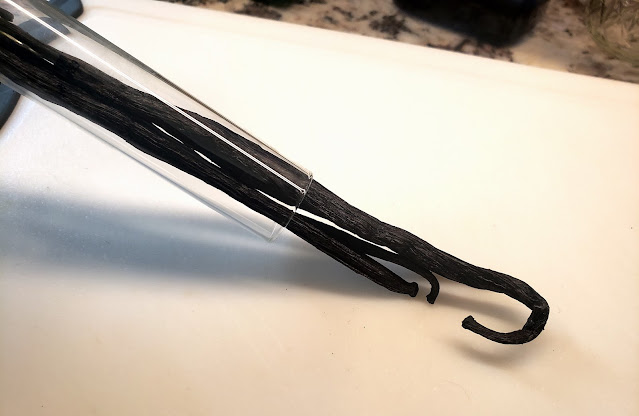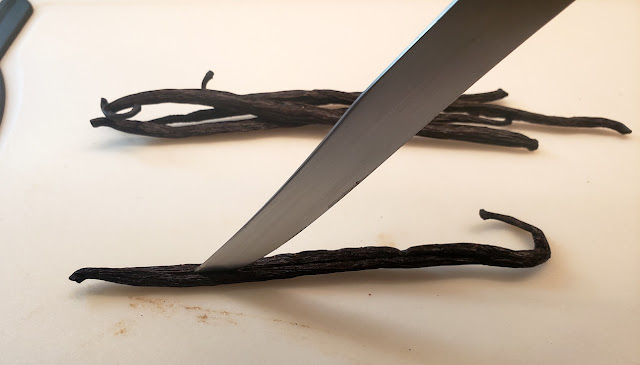Today I tried my hand at making vanilla extract. I have wanted to do this for many years now. Vanilla extract is one of my favorite ingredients while baking, unfortunately it is also incredibly expensive. Every so often I will see vanilla beans available in the store, remember that I want to make it, and then inevitably get distracted by some kind of sale. While I have never done vanilla before, I have made other extracts. Every year there are always various herbs tincturing in my cupboard.
In 2020, I purchased a set of vanilla beans to make my own extract… but they got lost in the pantry for a couple of months. When I found the tubes again I was not sure if they were still usable. So the beans ended up getting discarded. Now I know that vanilla beans are actually fermented before shipping which makes them last for several years. It was definitely a learning experience.
Here I am, in 2023, with two new tubes of vanilla beans. The flavor profile of the finished vanilla extract will depend on three things. What country did the beans come from, what type of alcohol was used, and how long were the beans in the extract. Vanilla beans from different parts of the world will have different flavors. Vanilla is like coffee in that regard. I purchased Madagascan vanilla from Costco. The two tubes cost me $18. There are a total of ten beans, five in each tube. Vanilla from Madagascar is renowned for having a very full body flavor whereas Tahitian vanilla has a more floral flavor.
The alcohol used to make vanilla extract should be at least 80 proof (40% ABV). In the United States, proof is calculated by multiplying the alcohol content by 2. So 40% alcohol has a proof of 80. This can vary country to country, always be sure and double check. Any time I make an extract I use Blue Ice vodka. Blue Ice vodka is made here in Idaho and is made of potatoes. Bourbon, rum, and brandy can also be used as long as they are at least 40% ABV. As a matter of personal preference, I shy away from making extracts using grain based alcohols. This is because alcohol made from grain often contains glyphosate from the herbicide Roundup. While I don’t feel comfortable using alcohol made from corn, wheat, or soy, my friend in Wisconsin uses 100 proof bourbon as her base and is always happy with the outcome.
The last component is time. The longer an extract sits, the more intense the flavor. It is recommended that vanilla sits anywhere from two months to a full year.
Making vanilla extract is incredibly easy. First, remove the vanilla beans from their packaging. Mine were in glass tubes. I saved the tubes to use in crafts later. The beans smelled divine. Next, I placed two horizontal cuts in each bean. These cuts were 3/4 of an inch from each end. Then I sliced the beans lengthwise in-between the two horizontal cuts. I wanted to allow the alcohol easy access to the inside of the vanilla beans while still allowing the beans to hold their shape. This will make removal easier after the extract is mature. The beans were leathery and tricky to cut. Be sure to use a sharp knife. They also left a fairly dark residue on the cutting board, however it was simple enough to clean up with bleach.
I placed the vanilla beans into my clean jars. I used two different jar sizes. One batch of five beans went into a quart jar (32 oz) while the other batch of five went into a 12 oz jar. This is because I ran across extremely conflicting advice on how many vanilla beans were needed to make vanilla extract. The Encyclopedia of Country Living by Carla Emery recommends 2 vanilla beans per quart (32 oz) of alcohol. Sally McKenney of Sally’s Baking recommends 5-6 vanilla beans per cup (8 oz) of alcohol. I decided to do an experiment. When September rolls around I will find out which I prefer! The vanilla beans were slightly too long to easily fit in the 12 oz jar so I ended up chopping them in half.
Next, I poured my vodka into each jar using a canning funnel. I heartily recommend canning funnels to anyone planing on making jam, pickles, extracts, or just using canning jars. As with any extract, be sure that the vanilla beans are completely submerged in the alcohol.
Finally, I put new lids and rings onto my canning jars, labelled
them, and set them aside. Tinctures and extracts should always be placed
away from sunlight in an area that maintains a stable temperature.
Shake once a week, or whenever you remember to do so.
This batch
of vanilla extract should be nice and strong by September, which will be
just in time for baking season. A little goes a long ways. Most of my
recipes call for a teaspoon or less of vanilla. Now to wait. I am
incredibly excited with how easy this was to process and my hands now
smell amazing.








No comments:
Post a Comment